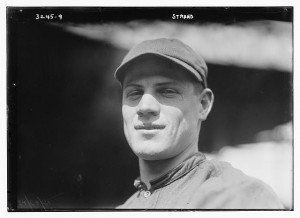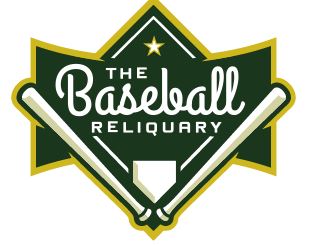Suppose you hit .384 in the Pacific Coast League – with 289 hits, 28 home runs and 138 RBI – and still didn’t get a call up to the major leagues. What would you do? Paul Strand did just that and, when he didn’t get a call up, he just went out and had a better year (in all four categories) the next season. In fact, many feel he went on to turn in one of the best – in not the best – minor league season ever. (BBRT will give a brief nod to a couple of other outstanding minor league stat lines at the end of this post. First, however, Paul Strand’s story.

Paul Strand – 325 hits in a single Pacific Coast League Season. Photo: Library of Congress; George Grantham Bain Collection.
In 1913, 19-year-old southpaw Paul Strand – after two seasons in the Northwestern League – found himself on the mound for the Boston Braves. Strand pitched in just 7 games and put up a 0-0 record and a 2.12 ERA. The following season, pitching for the 1914 “Miracle Braves” surprise NL pennant winners, Strand went 6-2, 2.44. Then in 1913, Strand’s professional baseball career took an unexpected turn. Just 21, Strand was 1-1 with a 2.38 ERA (in 6 games) when a serious arm injury marked the end his major league pitching career. Sold to Toledo of the American Association, Strand converted to the outfield, but hit only .215 in 61 games.
The 6’, 190-pounder didn’t give up, but honed his hitting skills while bouncing around the minor leagues (Toledo, Seattle, Peoria, Joplin, Yakima) before joining the Pacific Coast League’s Salt Lake City Bees early in the 1921 season.
Note: Strand did not immediately abandon the mound. In 1916-17, in addition to taking a spot in the outfield he went 16-12 as a pitcher (Toledo Iron Men and Seattle Giants), including a perfect game for Seattle on May 13, 1917 – a 1-0 win over the Spokane Indians. His advancing offensive skills, however, eventually made him a full-time position player.
It was with Salt Lake City that Strand made professional baseball history, putting together perhaps the best minor league season ever and earning both a spot in the Pacific Coast League Hall of Fame and a return (if brief) to the major leagues. It began somewhat quietly. In 1921, in 157 games (for Seattle and Salt Lake City), Strand hit .314, with nine homers and 95 RBI. But the PCL rocket was just leaving the launching pad.
Playing solely for Salt Lake City in 1922, Strand led the league in hits, home runs and batting average. Strand’s stat line looked like this:
G AB R H 2B 3B HR RBI Avg. SB
178* 752 138 289 52 13 28 138 .394 10
*The PCL, at the time, regularly played 200 games or more (a high of 230 for the 1905 San Francisco Seals.)
Surprisingly, those numbers did not earn the 28-year-old Strand a call to the majors. More surprisingly, Strand’s best performance was yet to come. In 1923, still with Salt Lake City, he had what some have called the best minor league season ever – topping his 1922 performance in every offensive category except triples (he hit 13 triples in each season). In fact, that year Strand set (and still holds) the professional baseball record for base hits (325) in a season. He also rapped 43 homers, scored 180 runs, drove in 187 and stole 22 bases. Here’s Strand’s 1923 stat line:
G AB R H 2B 3B HR RBI Avg. SB
194 825 180 325 66 13 43 187 .394 22
That second consecutive eye-catching season, actually did “catch the eye” of several major league teams. Ultimately, the Philadelphia Athletics Connie Mack offered Salt Lake City three players and cash that was reported at $100,000 to secure the hot-hitting outfielder. Strand, perhaps as shrewd off the field as he was talented on it, turned down the Athletics initial contract offer and held out for several weeks, finally signing for a reported $5,000.
Securing that contract would turn out to be Strand’s most significant achievement with the Athletics. Whatever the reason – some said he was overwhelmed by the publicity and expectations – the 30-year-old Strand hit only .228, with no homers and 13 RBI in 47 games for Philadelphia. (The Athletics also had Strand change his unorthodox cross-handed grip on the bat.) Mack gave up on Strand quickly, and shipped him off to Toledo of the American Association in late June.
From 1925-28, Stand once again found himself bouncing around the minor leagues, spending time with Toledo, Portland, Columbus, Atlanta and Little Rock. He hit at just about every stop – an overall average of .330 – but his reputation as a major league bust followed him and Strand never got another shot at the big leagues. Strand was out of baseball in 1929, with a lifetime minor league average of .334 and a major league mark of .224 (and a major league pitching record of 7-3, 2.37).
To close, let’s take a brief look at a couple of other outstanding minor league seasons. We’ll start with first baseman Joe Bauman, who had a remarkable season in 1954 (although at a much lower level than Strand’s great year). Playing for the C-level Longhorn League Roswell Rockets that season, the 32-year-old Bauman hit .400, with 72 homers (still the minor league record) and 224 RBI. Bauman, notably, never made it to the major leagues. In fact, only 102 of his 1,019 games were played above B-level (and only one game at AAA). Bauman retired after nine minor league seasons with a .337 career average, 337 home runs and 1,057 RBI. His legend does live on. Each year, the Joe Bauman Award is presented to the the minor leagues’ leading home run hitter.
Of course, not all great minor league seasons belong to players who failed to impress at the major league level. In 1925. Future MLB Hall of Famer Tony Lazzeri put up a .355 average, with 60 home runs and 222 RBI for the Salt Lake City Bees. Like Strand, his season earned him a shot in the majors – only Lazzeri capitalized on it. He went on to a 14-year MLB career as a shortstop/third baseman, primarily with the Yankees (also the Cubs, Dodgers and Giants). Lazzeri played in 6 World Series with the Yankees and one with the Cubs. As an 18-year-old Lazzeri was a teammate of Strand’s at Salt Lake City during the outfielder’s spectacular 1922 and 1923 seasons. For the Bees, Lazzeri hit .192 in 45 games in 1922 and then showed his promise by hitting .354 in 39 games the following season.





